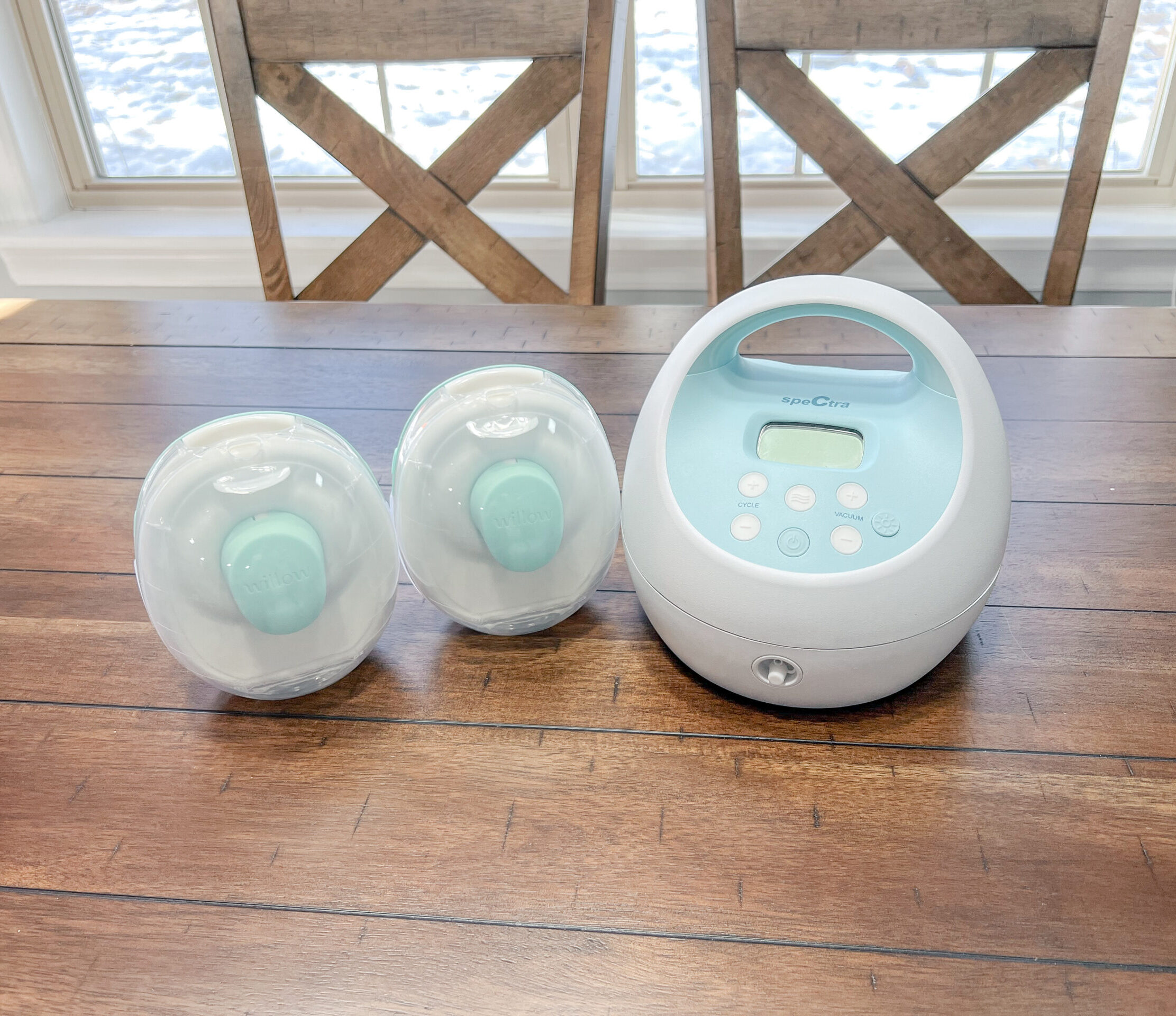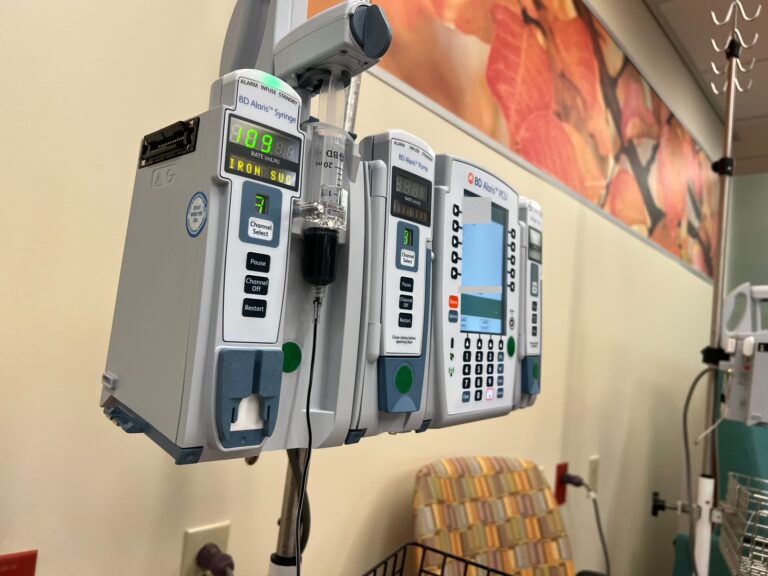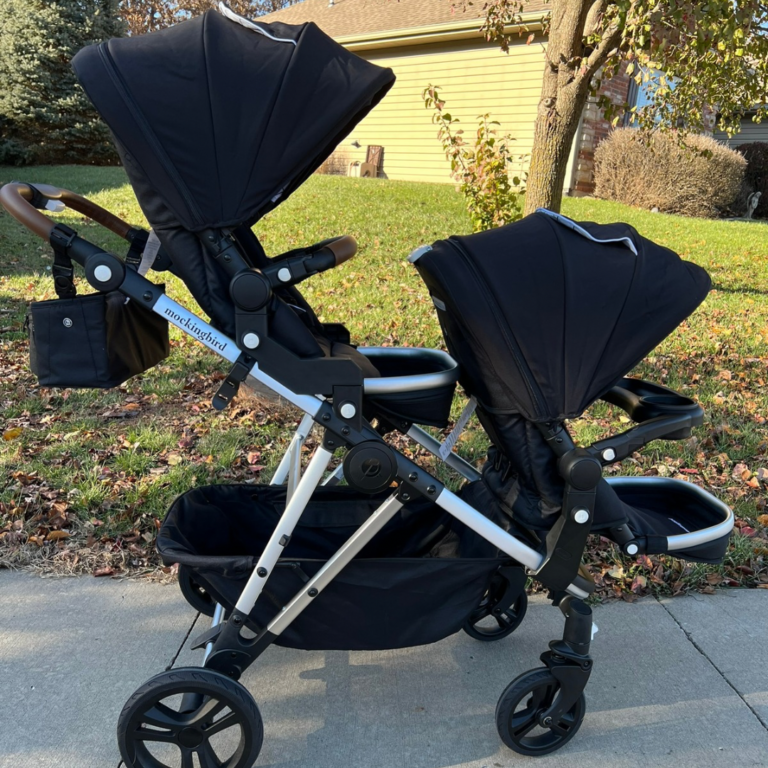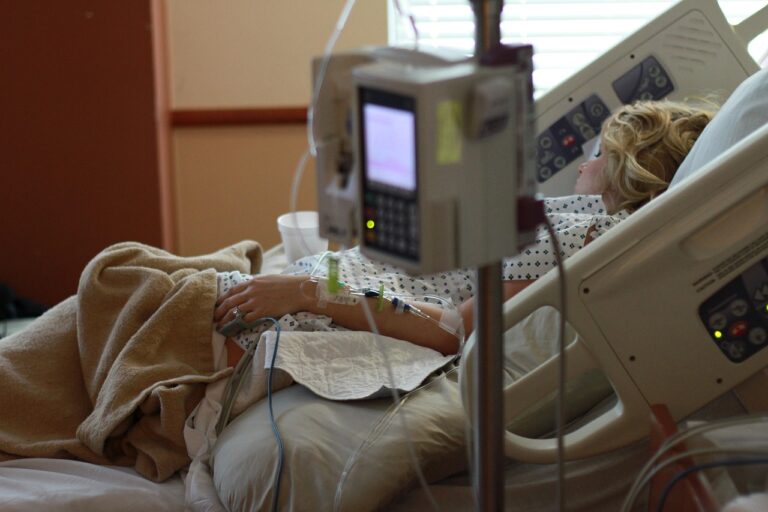The Ultimate Guide to Choosing the Best Breast Pump in 2025
This article may contain affiliate links. If you purchase through these links, I may earn a small commission at no additional cost to you.
There are hundreds of options when it comes to choosing a breast pump and I know how overwhelming it can be. I’ve done hours of research on breast pumps so you don’t have to! In the post, I will share my best tips with you so you can feel confident when purchasing your pump!
We’ll cover everything from the different types of pumps to best practices for cleaning and sanitizing your pump parts. I’ll also give you some things to look for along the way.
What Are The Different Types of Breast Pumps
There are four different categories of breast pumps, but they all essentially do the same thing, they allow you to express milk. The most common pumps you will see on the market or electric and wearable pumps.
Let’s break down your options when it comes to types of pumps:
- Manual Pumps: you use a handle or lever to create suction and express milk, which can only be done on one side at a time.
- Electric Pumps: These are battery-powered or an outlet to be plugged in, they use a motorized pump to create suction.
- Single vs Double: Electric pumps can be a single pump, meaning you can only express one breast at a time, or a double pump where you can express both. I highly recommend getting a double pump, as this is more efficient!
- Wearable Pumps: Electric pumps that don’t have tubing and can be worn inside your bra, making it very convenient to pump on the go. Most can be used as a single or double pump.
- Hospital-Grade Pumps: These pumps are designed for use in a hospital setting, have stronger suction, and are considered safe for multi-person use. Usually used for people who have to be separated from their baby immediately after birth, for example, if your sweet baby has to stay in the NICU. Sometimes you can rent a hospital pump through your insurance.
Do Breastfeeding Moms Need a Breast Pump?
Now you might be a mom who plans to stay home and exclusively breastfeed, and that’s wonderful! I still think all breastfeeding moms should get a breast pump!
During your journey, there are so many factors that might prevent you from nursing your baby directly. You could have an appointment that your baby can’t attend, you might want to go on a vacation or trip without your baby, or many other scenarios, life is unpredictable so it’s a good idea to have a breast pump on hand for any unexpected circumstances.
I used a breast pump when my daughter was only a month old. At the beginning of my pumping journey,I often felt engorged and needed to express milk after she was done eating. Then a few months later when she began sleeping longer stretches at night I needed to pump while she slept! It was also a nice way to start building a little freezer stash of breast milk.
Another time I found myself pumping more was when I had a clogged duct. When this happened my baby couldn’t always get all the milk out, so I would need to pump after breastfeeding her to help relieve the clog.
Obviously, if you plan to return to work and want to continue your breastfeeding journey you will need a pump. I returned to work when my daughter was about 4.5 months old and I would pump 3-4 times during the work day, my pump certainly got a lot of use during this time!
Factors to Consider When Choosing a Pump
Are you starting to get excited? I hope so, we are getting into the in-depth pump functions that are key when researching your breast pump!
You may be feeling a bit overwhelmed, and that’s perfectly normal. I will break down key features you should look for and how they can fit your specific needs.
1. Performance and Efficiency
- Suction power
- Hospital-grade vs. personal use suction strength. Hospital-grade suction is considered between 250-300mmHg. Many electric breast pumps also fall into this range. A wearable pump will be at the lower end or slightly below hospital-grade strength. You will want to carefully look at the suction on each pump you consider. Remember, the higher the suction strength, the more effective the pump will be at expressing milk.
- Adjustable suction levels for different needs (letdown vs. expression). Letdown mode for pumps is typically a “massage” mode used at the beginning of pumping to help get your milk flowing. The expression setting is used once your milk flows to provide a slower stronger suction to remove milk. It’s helpful when a pump has many options as some moms want a slower, less powerful suction and others might need a higher suction, it just depends on how your baby normally eats.
- Let-down and expression modes are possible when a breast pump has cycle speed and vacuum strength. Cycle refers to the speed of suction or how frequently the pump pulls, while vacuum strength is the strength of suction. The pump you purchase must have both a cycle and vacuum option, as these settings allow you to mimic how your baby suckles.
- Settings
- Pre-programmed vs. manual settings. A preprogrammed pump has built-in suction levels and speeds that automatically cycle through letdown and expression mode. Many Medela pumps have preprogrammed settings. Pumps with manual settings allow you to adjust the speed and suction yourself based on your comfort and needs, this was how my Spectra S1 pump worked.
- Digital vs. analog controls. My pump needed a digital screen so I could see my pump settings and the time I spent pumping. With analog controls, you will need to take mental note of your pump settings and how long you’ve been pumping. From what I’ve seen, digital controls or an app are more common.
- Noise level
- Impact of pump noise. You might be wondering, does the noise level matter?? For me, it did, because if I was going to pump in bed at night I didn’t want something too loud that would wake my baby and husband. Another thing to consider is if you plan to pump a lot in public you might want a quieter pump to help provide a more discreet experience.
- Determining pump noise. I recommend looking up YouTube videos of the pumps you want to buy. Many of these videos include a demonstration of how the pump will sound.
2. Convenience and Portability
- Portability and Size
- If you plan to travel a lot while pumping you need an option that is convenient and compact!
- Ease of carrying in diaper bags or purses. Battery and outlet pumps are big and it can be hard to find a bag that will fit your pump and all the parts you need for pumping. I found having a second diaper bag just for my Spectra S1 pump was the only way to fit everything I needed to pump when traveling.
- Wearable pumps. These are going to be the most portable pumps on the market. They are very compact and easy to carry around. You don’t need to worry about being near an outlet when pumping, best if you plan to pump on the go a lot!
- Battery vs outlet
- Outlet. Pumps that require you to be tethered to a wall can be inconvenient and uncomfortable, I don’t recommend a pump that is only powered by a wall outlet.
- Battery life. It is best to have a pump that has battery capability so you can pump anywhere around your house. My Spectra S1 had great battery life and I only had to charge it once a day or every other day, depending on how often I used it.
- Charging Time. If you plan to pump a lot you want to consider how long it will take your breast pump to charge, you don’t want to be waiting for half a day to use your pump. The Spectra S1
- Lights
- Built-in nightlights. This feature might not be important for everyone but I found it helpful when I had to pump in the middle of the night. The Spectra S1 had a small light on the handle that allowed me to see everything for pumping but I didn’t feel blinded by how bright it was.
3. Ease of Use and Maintenance
- Ease of Cleaning and assembly
- Number of parts. The average pump has 5-8 pieces per side that need to be cleaned after each pump. This can add up if you pump 3 or more times a day. You want to be sure the pump you get doesn’t have an excessive number of individual pieces you need to clean.
- Dishwasher-safe. Each pump will have its own specific guidelines for cleaning the parts. Some pieces require handwashing and some might allow you to place parts in the dishwasher, saving you time.
- Closed vs Open
- Closed breast pumps mean there is a barrier that prevents milk from getting into the tubing and pump. A closed system is more hygienic, and most pumps are made as a closed system. You should double-check the pump you purchase has a closed system.
Check Out This Breast Pump Comparison Chart
This chart shows how you might want to compare different breast pumps to find the best option. I’ve compared some of the popular models on the market to help get you started on your pump search.
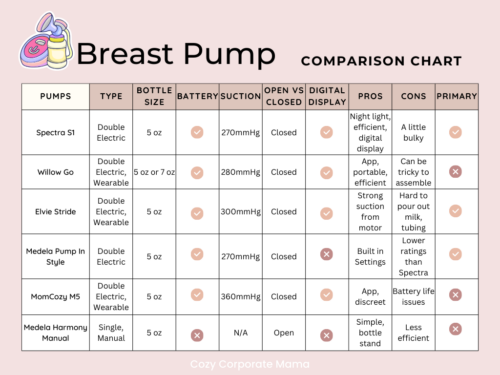
Primary vs Secondary Pump
Each mom will have a different breastfeeding journey and pumping needs. If you plan to pump exclusively or will have more pumping sessions than breastfeeding sessions, you will likely need a primary breast pump. If you plan to pump a few times during the day and breastfeed the rest of the day, you might be able to get away with just using a secondary pump.
What is a Primary Pump? It is a pump designed for daily, frequent use. These pumps have stronger suction, are often bulkier, and can be plugged into the wall. This pump should completely empty your breast. Most double-electric pumps with outlet capability and hospital-grade suction will fall into this category.
What is a Secondary Pump? This pump is designed for occasional use, often more discrete and portable. This pump should only be used a few times a day as it likely won’t empty you as well as a primary pump. Most wearable pumps are considered secondary pumps.
Many lactation consultants recommend that all breastfeeding moms have a primary pump as they are more reliable and effective. You can determine what type of pump best suits your needs.
I personally wanted a primary pump so I got the Spectra S1 with my first baby. This time around I still have that pump and it is in good condition for me to use when needed. The second time around I really wanted more portability to I decided to get the Willow Go as my secondary pump.
Flange Sizing
Getting the correct flange size is critical to a successful pumping journey. Most breast pumps come with two default flange sizes of 21mm or 24mm, and I am going to be honest these sizes are going to be way too big for most moms.
How to Get the Correct Flange Size
My top recommendation for every mom is to meet with a lactation consultant soon after having your baby. This is often covered by insurance and a lactation consult can help size you for a flange and can also help give you great tips for breastfeeding and using your breast pump.
If you don’t have the option to meet with a lactation consultant many breast pump brands have their own guides on how to measure your nipple for the best fit, you can also order a flange sizer on Amazon to help.
Importance of the Correct Flange Size:
- Milk Supply: The correct size will allow you to express the most milk as efficiently as possible. This is critical because if your breast is not emptied after pumping this could lead to clogged ducts and mastitis which can decrease your milk supply.
- Pain Prevention: I don’t particularly find pumping enjoyable but having the correct flange allowed it to be a tolerable experience for me. If your flange is too large or small this could cause you a lot of pain and even injury to your nipple.
It’s important to note that your nipple size can change throughout your breastfeeding and pumping journey so you might need to re-measure after a few months to ensure you still have the best flange fit.
Check out this Healthline article to see a diagram of how your flange should fit!
Cleaning and Maintenance Tips (how to sanitize properly, storage for milk, when to replace pump parts)
Cleaning and maintaining your breast pump and parts is important to ensure proper function and safety for your breastmilk. Most pumps will have you sterilize the pump parts before your first use, this is often achieved through boiling the parts but your pump manual will have the specific details on how to sterilize and clean your pump.
One major piece of maintenance is replacing pump parts. How frequently you pump will determine the need for how often you need to replace your parts, and your pump manufacturer will likely have specific guidelines. I’ve provided a helpful graphic below for general pump part replacement guidelines.
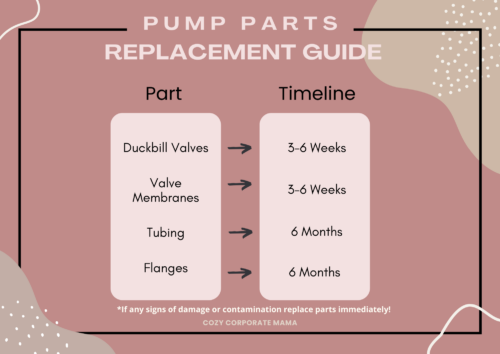
My first breast Pump – The Spectra S1
Finally, a quick look into my experience with the Spectra S1! I absolutely loved this pump. I felt I could customize the settings to what I needed for my letdown and milk expression! I used this pump during the first few months with my baby girl when I had so much extra milk and used this when I pumped after returning to work. This pump allowed me to have a successful and long breastfeeding journey.
Features I loved:
- Rechargable and portable
- Long charge life – I would only have to charge it 1-3x per week
- Built-in night light
- Hospital grade suction
Drawbacks:
- Bulky – made it a little inconvenient to travel with
This pump had so many positive features, and honestly, only one minor drawback that any primary double electric pump would have. If you are a mom looking for a strong and efficient pump I highly recommend the Spectra!
Key Takeaways
Choosing the right breast pump is a deeply personal decision that depends on your lifestyle, budget, and breastfeeding goals. Whether you need a hospital-grade pump for exclusive pumping, a hands-free option for multitasking, or a portable pump for occasional use, understanding the key features can help you make the best choice.
As a mom, convenience, comfort, and efficiency matter, so take the time to compare options, read reviews, and consider what will fit best into your daily routine. Don’t forget to factor in long-term usability—what works during maternity leave may not be as practical when transitioning back to work.
I know these tips will help you feel more confident in making the right breast pump decision for you, mama! If you want to learn how to get a free breast pump with insurance check out my blog post here!!!
